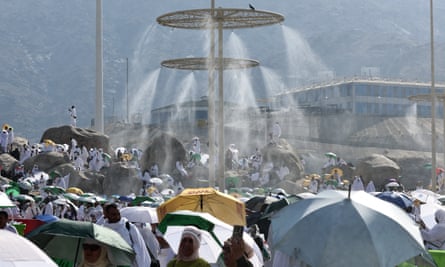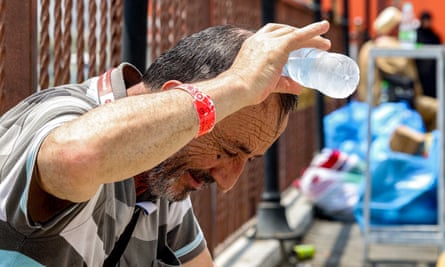Hoda Nagib and her husband had walked 20km in the baking sun in Saudi Arabia when she told him that she needed to rest. The couple, who are in their 60s, had just scaled Mount Arafat, along with thousands of other white-robed pilgrims on the hajj pilgrimage to Mecca, Islam’s holiest city, where temperatures as high as 51.8C have been recorded in the shade in recent days.
Nagib’s husband left her to perform a ritual known as the stoning of the devil. When he returned she had disappeared, their neighbour Walaa Roshdy explained.
Fellow pilgrims told him that his wife was suffering from exhaustion and had been taken to a hospital in Mina, Roshdy said. The husband – who Roshdy said had requested anonymity while he searches for his wife – went to the hospital, where staff told him she had been treated and had left. He has been unable to make contact since.
Roshdy, who works as a tour guide in Saudi Arabia, knows the couple from their home town of Tanta, in Egypt.
“We have contacted all relevant Saudi authorities but we are sure that this is going to take a long time because there are thousands of people who are missing,” he said.

More than 1,000 pilgrims have died while performing this year’s hajj in extreme heat conditions, according to figures compiled by Arab diplomats who spoke to the AFP news agency. The overwhelming majority, like the Nagibs, were unregistered pilgrims from Egypt, who entered Mecca without the official permits now required by Saudi law.
A senior Saudi official defended the country’s management of the pilgrimage on Friday. “The state did not fail, but there was a misjudgement on the part of people who did not appreciate the risks,” the official told AFP in the government’s first comments on the deaths.
All Muslims who are able to are required to make the hajj pilgrimage at least once in their lives. Saudi officials have taken steps to control crowding, and supply amenities such as air-conditioned tents to make the pilgrimage more bearable, but these are available only to registered pilgrims.
“Tour companies were supposed to warn people about all this, but they just want to make money,” said Roshdy.
Video posted to social media by Yasemin Mertcan, a Turkish tour operator, showed exhausted pilgrims laying by the side of exposed roads around Mecca, some splashing their unconscious companions with water in the hope of reviving them.
Mertcan’s footage also showed some pilgrims helping Saudi security forces load corpses in burial shrouds on to carts to be driven away.
“It has been very difficult this year. The number of dead and missing pilgrims is very high,” Mertcan said.

The Saudi authorities have said that they want to increase the number of annual pilgrims visiting Mecca year-round to 30 million by 2030, as part of the vision 2030 plan, which aims to wean the kingdom off of oil revenue with measures including increased tourism.
In an effort to avoid a repeat of a deadly crush in 2015, the Saudi government this year began a campaign called “no hajj without a permit”, with the Mecca authorities stressing that anyone attempting to enter the holy city without required permission would face strict penalties.
The opposition National Assembly party, composed of exiled Saudi dissidents, issued a condemnation of the Saudi Arabian authorities for their “negligence” towards the pilgrims, describing a “systematic media blackout” about the deaths.
The Nagibs arrived in Mecca two months before the hajj began, paying the equivalent of £2,155 to a broker in Egypt for the unofficial pilgrimage, where they shared a basic room with six others in a location outside the holy city, one that required more walking than official pilgrims.
They arrived shortly before intense early summer temperatures covered Saudi Arabia and much of the Middle East .
The Gulf is already one of the regions most vulnerable to the effects of the climate crisis, which supercharged the summer heatwave. The Climate Shift Index said the temperature in Mecca during the hajj was 2.8C above average, a rise it said was overwhelmingly attributable to climate change.
Even a small temperature rise can push the limits of human endurance for events such as the hajj, which occurs during the warmer months. A 2019 study from MIT warned that rising temperatures during the summer months could pose “extreme danger” to pilgrims attending the event.
Roshdy said that many pilgrims were older, having saved for years to attend the hajj, and had underlying conditions that increased the risks posed by hours outdoors in the extreme heat.
“Those people cannot walk for all these distances in such an extremely hot weather,” he said. “All of this is because the tourism companies and brokers want to make money.”
https://news.google.com/rss/articles/CBMijAFodHRwczovL3d3dy50aGVndWFyZGlhbi5jb20vd29ybGQvYXJ0aWNsZS8yMDI0L2p1bi8yMS9vbmUtbWFucy1kZXNwZXJhdGUtc2VhcmNoLWZvci13aWZlLWFzLW1vcmUtdGhhbi0xMDAwLWhhamotcGlsZ3JpbXMtZGllLWluLWV4dHJlbWUtaGVhdNIBjAFodHRwczovL2FtcC50aGVndWFyZGlhbi5jb20vd29ybGQvYXJ0aWNsZS8yMDI0L2p1bi8yMS9vbmUtbWFucy1kZXNwZXJhdGUtc2VhcmNoLWZvci13aWZlLWFzLW1vcmUtdGhhbi0xMDAwLWhhamotcGlsZ3JpbXMtZGllLWluLWV4dHJlbWUtaGVhdA?oc=5
2024-06-21 20:26:00Z
CBMijAFodHRwczovL3d3dy50aGVndWFyZGlhbi5jb20vd29ybGQvYXJ0aWNsZS8yMDI0L2p1bi8yMS9vbmUtbWFucy1kZXNwZXJhdGUtc2VhcmNoLWZvci13aWZlLWFzLW1vcmUtdGhhbi0xMDAwLWhhamotcGlsZ3JpbXMtZGllLWluLWV4dHJlbWUtaGVhdNIBjAFodHRwczovL2FtcC50aGVndWFyZGlhbi5jb20vd29ybGQvYXJ0aWNsZS8yMDI0L2p1bi8yMS9vbmUtbWFucy1kZXNwZXJhdGUtc2VhcmNoLWZvci13aWZlLWFzLW1vcmUtdGhhbi0xMDAwLWhhamotcGlsZ3JpbXMtZGllLWluLWV4dHJlbWUtaGVhdA
Tidak ada komentar:
Posting Komentar